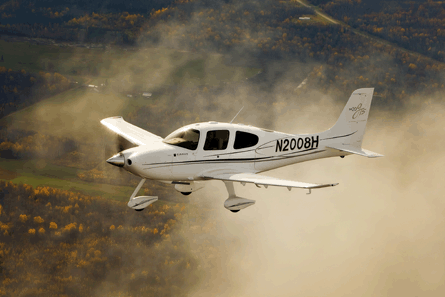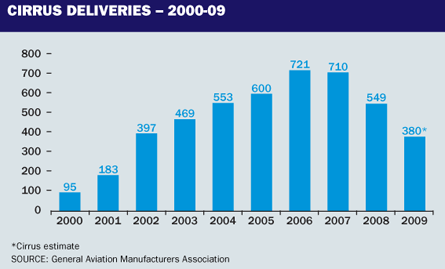While slumping sales continue to force other general aviation manufacturers to downsize, Cirrus Design is recalling workers to increase production.
Cirrus this month recalled 55 workers and increased production from six to eight single-engine piston aircraft a week in response to an upturn in sales. The Minnesota-based manufacturer is confident sales will continue their upward trend in the second half of the year, allowing it to recall more workers and further increase production. "We do have indications that point to more favourable things in the second half of the year," says marketing vice- president Todd Simmons.
Simmons believes Cirrus is seeing the benefits of cutting back earlier and more drastically than its rivals. Cirrus last August let go 500 of its 1,300 employees and at the beginning of this year was down to fewer than 700 staff.
"We made changes last year that enabled us to match production to demand this year. We're in a great position," Simmons says.
 |
|---|
© Cirrus |
EFFICIENT RAMP-UP
Cirrus delivered only 39 aircraft in the first quarter, but in April was able to increase production to six aircraft a week without increasing headcount. As further evidence of how much leaner and more efficient it is than it was a year ago, Cirrus in June was able to increase production by a further 33% with an increase of only 8% in headcount. Simmons says Cirrus has the flexibility to quickly increase production yet again, with plenty of spare capacity and a large group of fully trained employees on furlough.
Restructuring was only half the battle - critically, sales are showing signs of life. "We began to see signs of a recovery in late February and March," says Simmons. Two-thirds of sales are in the USA, but recent growth has come domestically and internationally.
Helping kick start sales are new features including a known ice protection system - certificated in April by the US Federal Aviation Administration for the SR22 and Turbo - and the Garmin Prospective cockpit, says Simmons: "Flight into known ice has been a big market hit and it certainly differentiates us."
Cirrus may also be operating in a market sweet spot as business aircraft users look for more efficient options. Simmons says some new customers this year are owner-operators of turbine aircraft downgrading to pistons. Customers with pistons and turbines are flying their pistons more and even growing their Cirrus fleets.
Cirrus also reports increased interest from flight schools and investors looking at setting up air taxis. The air taxi market has been littered with casualties, but Simmons says Cirrus has had relatively little exposure compared with other manufacturers and the long-term air taxi outlook is bright.
 |
|---|
Another positive development is in the used aircraft market. Simmons reports "some stabilisation" of used inventories, with values and the level of aircraft available "coming back to more normal levels".
But Cirrus is still a long way from its peak in 2006, when it produced 721 aircraft with a long queue of customers waiting for delivery. New customers now wait six to eight weeks for delivery, an improvement from early this year when Cirrus was still selling off excess inventories.
The company is now on track to deliver roughly 380 aircraft this year, down from 549 in 2008. It has not produced fewer than 390 aircraft since 2001, when the SR20 line was still ramping up.
But Cirrus was looking earlier this year at only delivering about 320 aircraft and Simmons says demand is exceeding the new production rate of eight aircraft a week: "The hope is in the next three to six months we'll be able to recall more workers. So far we like what we see - the indications are positive."
Source: Flight International























